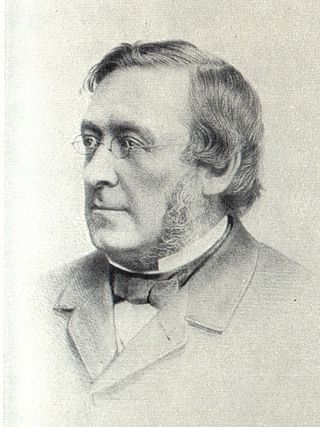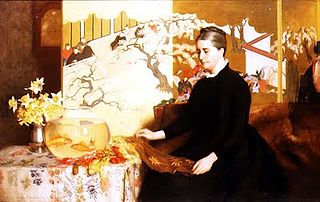
The Dean Cemetery is a historically important Victorian cemetery north of the Dean Village, west of Edinburgh city centre, in Scotland. It lies between Queensferry Road and the Water of Leith, bounded on its east side by Dean Path and on its west by the Dean Gallery. A 20th-century extension lies detached from the main cemetery to the north of Ravelston Terrace. The main cemetery is accessible through the main gate on its east side, through a "grace and favour" access door from the grounds of Dean Gallery and from Ravelston Terrace. The modern extension is only accessible at the junction of Dean Path and Queensferry Road.

David Stevenson MICE FRSE FRSSA was a Scottish lighthouse designer, who designed over 30 lighthouses in and around Scotland, and helped continue the dynasty of lighthouse engineering founded by his father.

Charles Alexander Stevenson MICE MIEE FRSE was a Scottish lighthouse engineer who built twenty-three lighthouses in and around Scotland.

Helen Brodie Cowan Bannerman was a Scottish writer of children's books. She is best known for her first book, Little Black Sambo (1899).

Thomas Hamilton was a Scottish architect, based in Edinburgh where he designed many of that city's prominent buildings. Born in Glasgow, his works include: the Burns Monument in Alloway; the Royal High School on the south side of Calton Hill ; the Royal College of Physicians of Edinburgh; the George IV Bridge, which spans the Cowgate; the Dean Orphan Hospital, now the Dean Gallery; the New North Road Free Church, now the Bedlam Theatre; Cumstoun, a private house in Dumfries and Galloway; and the Scottish Political Martyrs' Monument in Old Calton Cemetery, Edinburgh.
James Moncreiff, 1st Baron Moncreiff of Tullibole LLD was a Scottish lawyer and politician.

Sir Robert Christison, 1st Baronet, was a Scottish toxicologist and physician who served as president of the Royal College of Physicians of Edinburgh and as president of the British Medical Association (1875). He was the first person to describe renal anaemia.

Alexander Oswald Brodie was an American military officer and engineer. Earning his initial reputation during the Indian wars, he came to prominence for his service with the Rough Riders during the Spanish–American War. His friendship with Theodore Roosevelt then led to Brodie being appointed Governor of Arizona Territory from 1902 to 1905.

The Grange is an affluent suburb of Edinburgh, just south of the city centre, with Morningside and Greenhill to the west, Newington to the east, The Meadows park and Marchmont to the north, and Blackford Hill to the south. It is a conservation area characterised by large early Victorian stone-built villas and mansions, often with very large gardens. The Grange was built mainly between 1830 and 1890, and the area represented the idealisation of country living within an urban setting.
Alexander James Adie FRSE MWS was a Scottish maker of medical instruments, optician and meteorologist. He was the inventor of the sympiesometer, patented in 1818.

James Cadenhead was a Scottish landscape and portrait painter.

Robert Boog Watson FRSE was a Scottish malacologist and minister of the Free Church of Scotland best known as the author of the report on the Scaphopoda and Gastropoda collected during the H.M.S. Challenger expedition to survey the world's oceans from 1873 to 1876. Watson also described various Opisthobranchia from Madeira.

John Alexander Carfrae (1868–1947) was a Scottish architect of particular note in the field of innovative school design. He was considered one of the best architects of his generation, but his works were rather limited as he was constrained to the standard board school formats.

Sir Patrick Heron Watson was an eminent 19th-century Scottish surgeon and pioneer of anaesthetic development. He was associated with a number of surgical innovations including excision of the knee joint, excision of the thyroid and excision of the larynx for malignant disease. He was President of the Royal College of Surgeons of Edinburgh on two occasions, an unusual honour, and was the first President of the Edinburgh Dental Hospital. He was a great advocate of women training in medicine and surgery and did much to advance that cause.

Francis Brodie Imlach FRCSEd (1819-1891) was a Scottish pioneer of modern dentistry, and the first person to use chloroform on a dental patient. He helped to raise the profile of dentistry from a back street trade to full professional status.

John Duncan, LLD FRCSEd FRSE was a Scottish surgeon best known for his surgical teaching at the University of Edinburgh and the Edinburgh Extramural School of Medicine. He was a pioneer of the use of electricity in surgery both for surgical cautery and for tumour necrosis. On the death of his father James Duncan in 1866 he became a director of the major drug manufacturer Duncan Flockhart & Co, which had been founded by his grandfather, also John Duncan. He served as President of the Royal College of Surgeons of Edinburgh 1889 to 1891.

Royal Terrace is a grand street in the city of Edinburgh, Scotland, on the north side of Calton Hill within the New Town and part of the UNESCO World Heritage Site inscribed in 1995, built on the south side of a setted street, facing the sloping banks of London Road Gardens, formerly Royal Terrace Gardens, with views looking north towards Leith and the Firth of Forth.
Major General William Burney Bannerman CSI FRSE was a 19th and 20th century high-ranking Scottish military surgeon who worked in the Indian Medical Service. As director of the plague research laboratory, he conducted experiments on plague vaccines along with Waldemar Haffkine. He was one of the first to use Henry Littlejohn's analytical techniques on a large scale, demonstrating the value of inoculation.
Robert Macfie Thorburn FRSE (1828–1896) was a 19th-century Swedish-Scots businessman and Swedish politician.
Elspeth Jane Boog Watson sometimes Boog-Watson was a teacher, writer and broadcaster.















